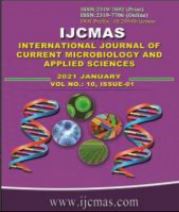


 National Academy of Agricultural Sciences (NAAS)
National Academy of Agricultural Sciences (NAAS)

|
PRINT ISSN : 2319-7692
Online ISSN : 2319-7706 Issues : 12 per year Publisher : Excellent Publishers Email : editorijcmas@gmail.com / submit@ijcmas.com Editor-in-chief: Dr.M.Prakash Index Copernicus ICV 2018: 95.39 NAAS RATING 2020: 5.38 |
A two year field experiment was conducted at Central Research Station of College of Agriculture, OUAT, Bhubaneswar, during two consecutive kharif and rabi seasons of 2017-18 and 2018-19 titling “Integrated nutrient management in rice (Oryza sativa L.)and its residual effects on maize (Zea mays L.) under different weed management practices” to accesses the performance of the system and nutrients and microbial status of soil at the end of rice-maize cropping system The field experiment was laid out in a RBD design for rice with four treatments and 15 replications and split-plot design for maize with four(4) main plot treatment five(5) subplot treatments and three replications. The four INM treatments for rice were D1=100% STBN, D2=50%STBN+50%FYM, D3=50%STBN+50%VC and D4=50%STBN+50%PM. There were altogether 20 treatment combinations for maize with Main Plot (Nutrient management, i.e. residual effects of treatments given to rice crop) and Sub-Plot (Weed management): W1= Topramezone @ 25g a.i/ha, W2=Tembotrione@105g a.i./ha,W3=Topramezone @ 25ga.i.+Atrazine @ 250ga.i./ha as tank mix, W4= Tembotrione@ 105g a.i. + Atrazine@ 250g a.i./ha and W5=Weedy check. Integrated application of nutrients through inorganic and organic sources (such as FYM, Vermicompost and poultry manure) found to be significantly improves the soil microbial population as well as dehydrogenase enzyme activity over sole inorganic fertilizer application in Rice-maize system.
 |
 |
 |
 |
 |